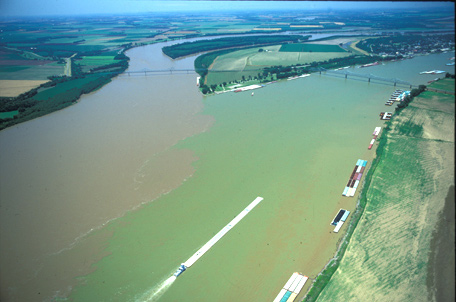On the evening of 14 November 1803, Lewis and Clark camped on the point between the Ohio (right) and Mississippi Rivers near today’s Cairo, Illinois—or wherever it actually was two hundred years ago. By now they had rowed, poled, dragged, and occasionally sailed their boats a total of 981 miles in 76 days, including rest stops. The next day they crossed to the west bank of the Mississippi and began practicing techniques for making celestial observations to determine latitudes and longitudes, which Lewis had learned from Andrew Ellicott and Robert Patterson back in Pennsylvania. Their calculations were incorrect, but Clark, with some previous experience in surveying, “made a partial survey of the point”—a surveyor’s “station”—and measured the widths of the two rivers
Two days later, an admiring Shawnee Indian offered Lewis three beaver skins for his Newfoundland dog, Seaman, but “of course there was no bargain.” The dog, Lewis wrote, “I prised much for his docility and qualifications generally for my journey.” These qualifications included a comfort with water: Newfoundland dogs had long been bred to help trawlers retrieve their nets and to guide shipwrecked sailors through surf. The journals contain no hint that the Corps’ mascot was ever called on to help with a water rescue, though there were several occasions when he could have been.
Clark had been to this place at least three times in the 1790s, and in 1795 drew a map of the confluence. In 1780 his brother George had built a fort about four miles down the Mississippi from here. On 18 November 1803, the two captains and eight men paddled a canoe down the Mississippi on a sentimental journey to the abandoned post, Fort Jefferson. To men and women of Clark’s day, American history was family history.
From Discovering Lewis & Clark from the Air
Photography by Jim Wark
Text by Joseph Mussulman
Reproduced by permission of Mountain Press
Experience the Lewis and Clark Trail
The Lewis and Clark Trail Experience—our sister site at lewisandclark.travel—connects the world to people and places on the Lewis and Clark Trail.
Discover More
- The Lewis and Clark Expedition: Day by Day by Gary E. Moulton (University of Nebraska Press, 2018). The story in prose, 14 May 1804–23 September 1806.
- The Lewis and Clark Journals: An American Epic of Discovery (abridged) by Gary E. Moulton (University of Nebraska Press, 2003). Selected journal excerpts, 14 May 1804–23 September 1806.
- The Lewis and Clark Journals. by Gary E. Moulton (University of Nebraska Press, 1983–2001). The complete story in 13 volumes.


